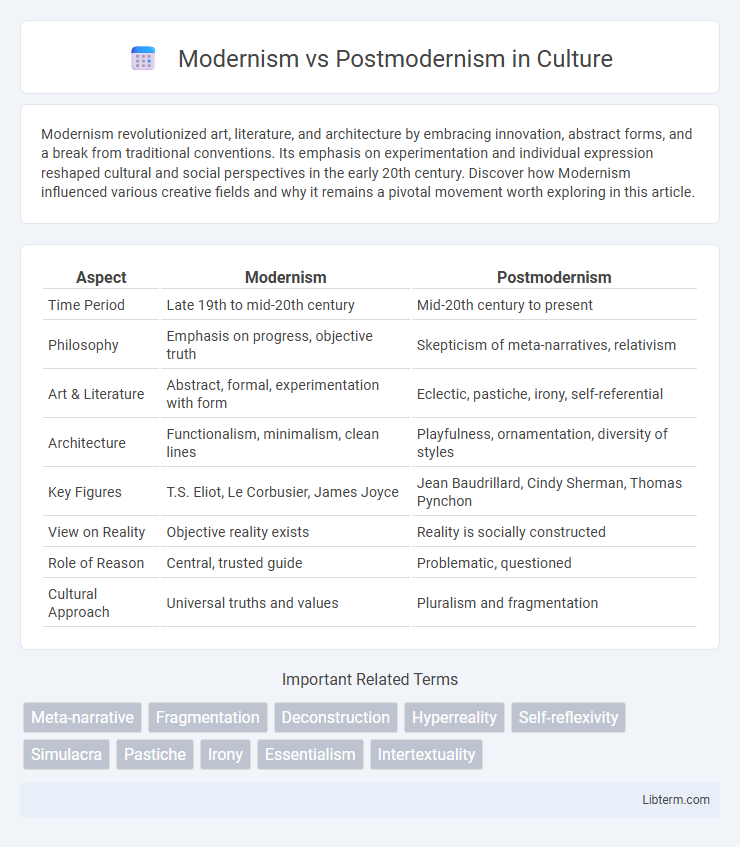Modernism revolutionized art, literature, and architecture by embracing innovation, abstract forms, and a break from traditional conventions. Its emphasis on experimentation and individual expression reshaped cultural and social perspectives in the early 20th century. Discover how Modernism influenced various creative fields and why it remains a pivotal movement worth exploring in this article.
Table of Comparison
| Aspect | Modernism | Postmodernism |
|---|---|---|
| Time Period | Late 19th to mid-20th century | Mid-20th century to present |
| Philosophy | Emphasis on progress, objective truth | Skepticism of meta-narratives, relativism |
| Art & Literature | Abstract, formal, experimentation with form | Eclectic, pastiche, irony, self-referential |
| Architecture | Functionalism, minimalism, clean lines | Playfulness, ornamentation, diversity of styles |
| Key Figures | T.S. Eliot, Le Corbusier, James Joyce | Jean Baudrillard, Cindy Sherman, Thomas Pynchon |
| View on Reality | Objective reality exists | Reality is socially constructed |
| Role of Reason | Central, trusted guide | Problematic, questioned |
| Cultural Approach | Universal truths and values | Pluralism and fragmentation |
Defining Modernism and Postmodernism
Modernism, emerging in the late 19th and early 20th centuries, emphasizes rationality, order, and a belief in progress through science and technology. Postmodernism, arising in the mid-20th century, challenges these ideals by embracing skepticism, relativism, and the rejection of grand narratives or universal truths. Key figures in Modernism include T.S. Eliot and Le Corbusier, while Postmodernism is associated with thinkers like Jean-Francois Lyotard and Jacques Derrida.
Historical Context and Origins
Modernism emerged in the late 19th and early 20th centuries as a response to industrialization, urbanization, and the devastation of World War I, emphasizing innovation, abstraction, and a break from traditional forms. Postmodernism arose in the mid-20th century, particularly after World War II, as a critique of Modernist ideals, embracing skepticism, irony, and cultural relativism while rejecting grand narratives. Both movements reflect historical shifts in society, technology, and philosophy, with Modernism rooted in progress and universal truths, and Postmodernism challenging those assumptions through pluralism and fragmentation.
Key Philosophical Foundations
Modernism emphasizes rationality, universal truths, and objective knowledge, rooted in Enlightenment ideals and the belief in progress through science and reason. Postmodernism challenges these foundations by rejecting grand narratives, embracing relativism, and highlighting the role of language, power, and culture in constructing reality. Key figures like Jean-Francois Lyotard and Michel Foucault critique modernist assumptions, promoting pluralism and skepticism towards absolute meaning.
Core Themes and Motifs
Modernism emphasizes themes of progress, individualism, and the search for meaning through formal experimentation, often featuring motifs of isolation and fragmented reality. Postmodernism challenges these ideals by embracing skepticism, irony, and pastiche, highlighting themes of pluralism, relativism, and the deconstruction of meta-narratives. Key motifs in postmodern works include paradox, intertextuality, and the blurring of boundaries between high and low culture.
Artistic Expression and Styles
Modernism in artistic expression emphasizes abstraction, minimalism, and a pursuit of universal truths through innovative techniques and structured forms, as seen in the works of Picasso and Mondrian. Postmodernism rejects these ideals, favoring eclecticism, pastiche, and irony to challenge notions of originality and authority, exemplified by artists like Jeff Koons and Cindy Sherman. The shift from Modernism to Postmodernism reflects a move from rigid stylistic boundaries to a pluralistic and fragmented approach in visual arts and literature.
Literary Characteristics and Techniques
Modernism in literature emphasizes fragmented narratives, stream of consciousness, and a focus on subjective experience, often exploring alienation and existential doubt through experimental forms. Postmodernism breaks down traditional literary boundaries further by embracing metafiction, intertextuality, and pastiche, frequently challenging notions of authorship and objective truth. Techniques such as unreliable narrators and nonlinear timelines are common, reflecting cultural skepticism and the fluidity of meaning.
Architecture: Modernism vs. Postmodernism
Modernism in architecture emphasizes functionalism, simplicity, and the absence of ornamentation, characterized by clean lines, glass facades, and open floor plans as seen in works by Le Corbusier and Ludwig Mies van der Rohe. Postmodernism reacts against Modernism's rigidity by incorporating eclectic styles, historical references, and decorative elements, exemplified by architects like Michael Graves and Robert Venturi. The contrast between Modernism's pursuit of universality and Postmodernism's embrace of context and symbolism defines their architectural legacy.
Influential Figures and Works
Modernism, characterized by figures such as James Joyce with "Ulysses" and Virginia Woolf's "Mrs. Dalloway," emphasizes experimental techniques and a search for deeper meaning in fragmented narratives. Postmodernism, represented by authors like Thomas Pynchon with "Gravity's Rainbow" and Jean Baudrillard's critical theory, challenges notions of objective reality through pastiche, irony, and metafiction. These influential works and thinkers illustrate the shift from Modernism's quest for universal truths to Postmodernism's skepticism and playful deconstruction of established narratives.
Impact on Contemporary Culture
Modernism shaped contemporary culture through its emphasis on innovation, abstraction, and a belief in progress, influencing fields such as architecture, literature, and art. Postmodernism challenged these ideals by embracing skepticism, irony, and pluralism, leading to a more fragmented and diverse cultural landscape. The ongoing dialogue between both movements continues to impact contemporary creative expressions and social thought.
Lasting Legacy and Ongoing Debates
Modernism's lasting legacy is marked by its emphasis on universal truths, innovation in art and literature, and the pursuit of progress through reason and structure. Postmodernism challenges these principles by embracing relativism, skepticism toward grand narratives, and celebrating diversity and multiplicity in cultural expressions. Ongoing debates center on whether postmodern critiques undermine objective knowledge or expand creative freedom, influencing contemporary philosophy, architecture, and critical theory.
Modernism Infographic

 libterm.com
libterm.com